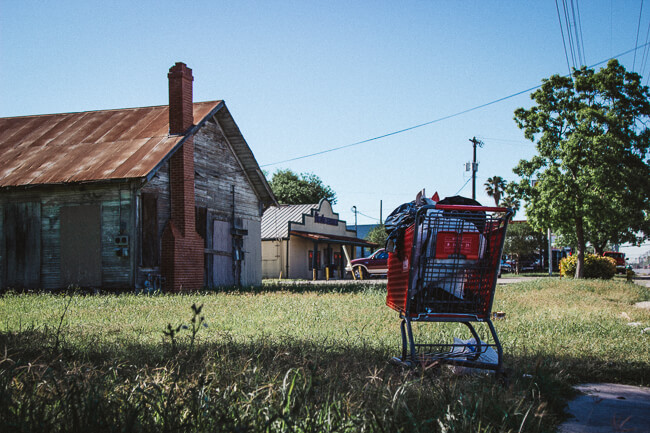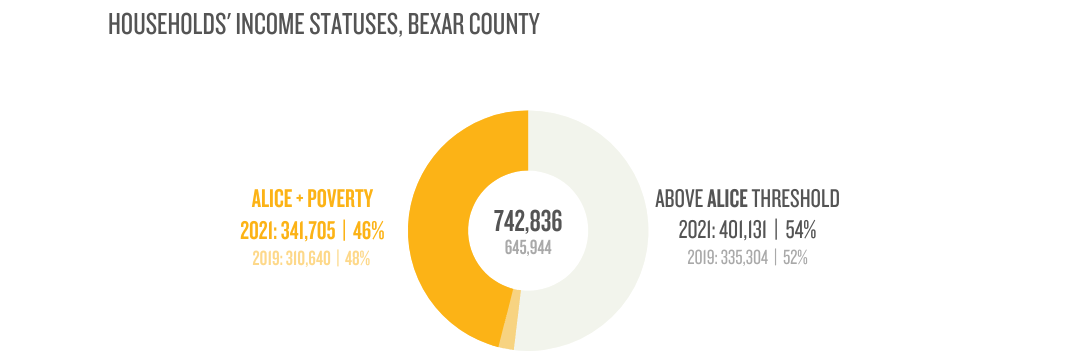

Around half of all Bexar County residents—roughly 300,000—are struggling to pay their monthly bills. Some of these neighbors have an income below the federal poverty line, but most don’t. They make too much money to qualify for Medicaid or food programs, but not enough to meet what the United Way calls a “survival budget.” For families in that gap between poverty and security—and the gap looks different in every city—United Way uses the acronym ALICE: asset limited, income constrained, employed.

United For ALICE provides resources to understand the difficulties for families earning an income above the Federal Poverty Level, but not enough to afford the basic essentials of a household budget. In Bexar County, ALICE includes many of the neighbors we interact with everyday—employees at restaurants and grocery stores, schools and churches. The median income in Bexar County is $58,288—below the survival budget for any family of four.
Often when we hear phrases like “struggling to make ends meet” we think of people who are recovering from a major setback or disaster. But data from around the United States tells us that even without major medical emergencies, car accidents, or job loss, many hard-working American families struggle to make enough money to meet their baseline monthly needs.
The numbers, as big and glaring as they are, sometimes blur the faces of these neighbors, lumping them into demographics or data. But it’s important to remember that each mom worried about how she will pay for her kids’ meals, each dad putting off a doctor’s visit, has a story. They have goals for their families—and unique strengths that have allowed them to make it this far.

The following vignettes are based on real reporting and data-based simulations. The characters are fictional, but the situations described would be familiar to many of our neighbors.
Camille is a single mom in her early 20s. She was about six credits shy of her associates degree when she dropped out of college to get married and have a baby. Her husband left soon after the baby was born, leaving Camille dependent on her mom and sister for child care while she went back to full time work. She took a job at Bill Miller BBQ for $12 per hour, and quickly got promoted to cashier, making $14 per hour.
Her apartment near Mission San Jose is about $600 per month, and for a while, Camille felt like her head was above water. She even started thinking about going back to school.
Then her mom was diagnosed with Alzheimer’s disease, and her sister moved to another city. Her landlord is planning to raise the rent to $750 per month next year, and she’s going to have to find safe, quality child care for her son if she wants to keep her job. The only certified day care she could get him into near her apartment charges $125 per week.
Going back to school is out of the question for now, and she wonders how she is going to come up with another $650 per month to cover childcare and the rent increase.
Alex and Marnie grew up in rural West Texas and moved to San Antonio after they got married. Alex is an x-ray tech and Marnie is an LVN, and their plan was to earn additional certifications to boost their salaries. Then they would buy a house and start a family.
They found a studio apartment near the Medical Center where they both work. Public transportation allowed them to get by with just Alex’s old two-seater truck in car-centric San Antonio.
That all changed when Marnie got pregnant with twins. They decided that Marnie should take extended leave to be with the kids during their first year.
Now the two young parents are trying to stretch Alex’s $64,000 salary to pay rent for a two bedroom condo, and payments on a used family car. Every few months, Marnie looks through part-time nursing jobs to see if any of them would work with daycare hours, while also paying enough to cover the added child care expense and help with the other bills.
Alex is looking for a way to earn more certifications or a degree, but both time and money seem too tight right now.
Carl is a bus driver for VIA, making $21 per hour, and his wife Roberta had been on the facilities staff for the City of San Antonio. They have two teenagers, a boy and a girl. They wanted to get the kids into a good public school that would steer them toward good colleges, so they found a highly rated high school on GreatSchools.org in North East ISD and felt lucky to get a nearby 3 bedroom apartment for $1,400 per month.
Roberta found a part-time custodian job for a large church nearby, and while it was a lower salary—she makes about $15,000 per year—she would be paying less in gas for her commute, and would be able to shuttle kids around after school. They want their kids to have well-rounded college applications, but the cost of extracurricular sports and clubs often means Carl has to pick up overtime shifts.
When their son broke his ankle playing soccer, the medical expenses made it so that they had to start staggering bill payments. During that time, Roberta decided to wait to see a dentist about a toothache, and what would have been a simple filling required a more expensive procedure.
Carl and Roberta feel like they can get through these occasional bumps in the road, but they worry what will happen when it’s time to start paying for college. They want to help, and for their kids not to start life saddled with college debt, but they wonder if that will be possible.
There are numerous other scenarios that might describe an ALICE household, and limitless ways a stable situation can suddenly change.
To help us understand more about these economic realities, the United Way of San Antonio and Bexar County developed Making Tough Choices, a simulation exercise that puts you in the shoes of a typical ALICE family. Take a few minutes to take the challenge and experience some of the tough choices your neighbors are making each day.